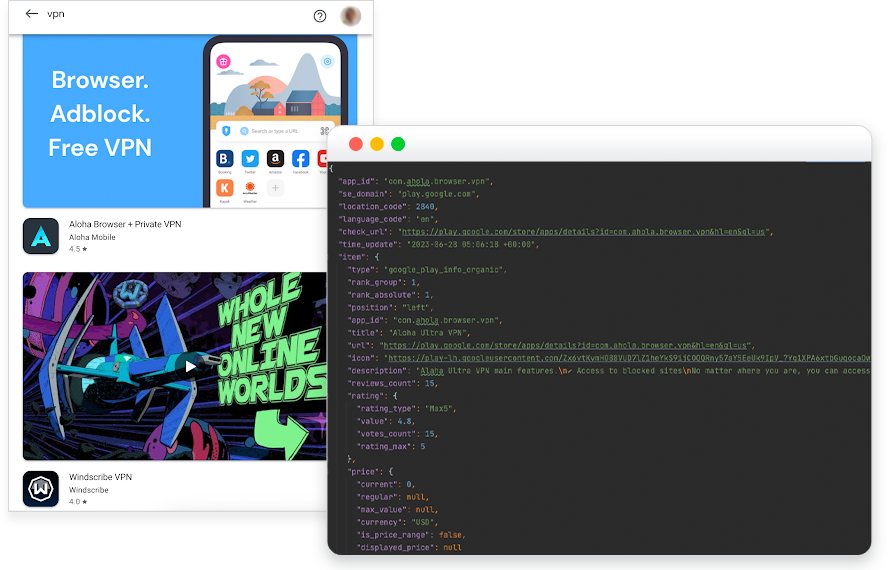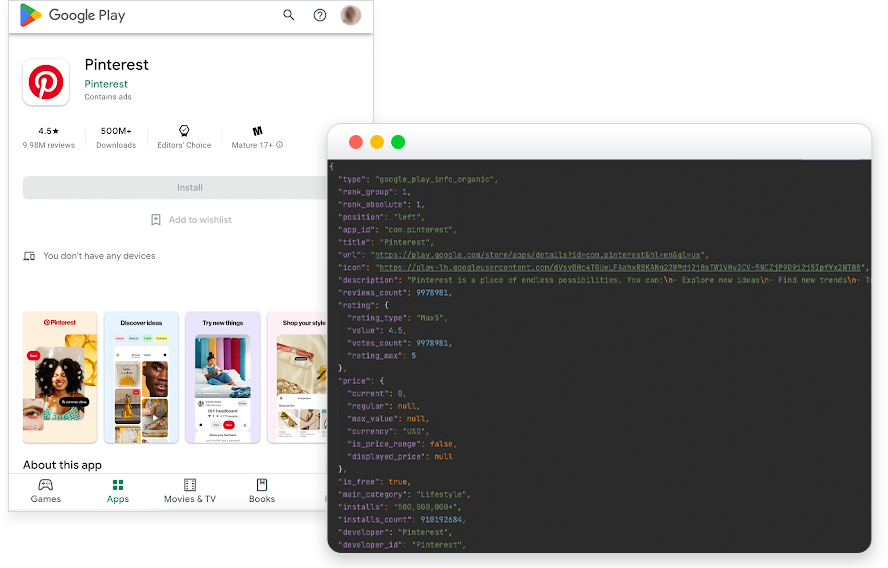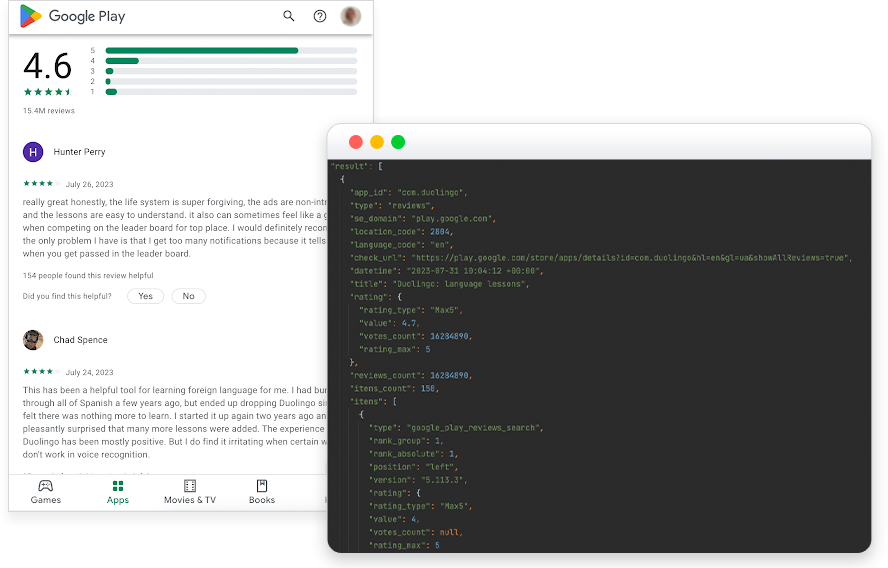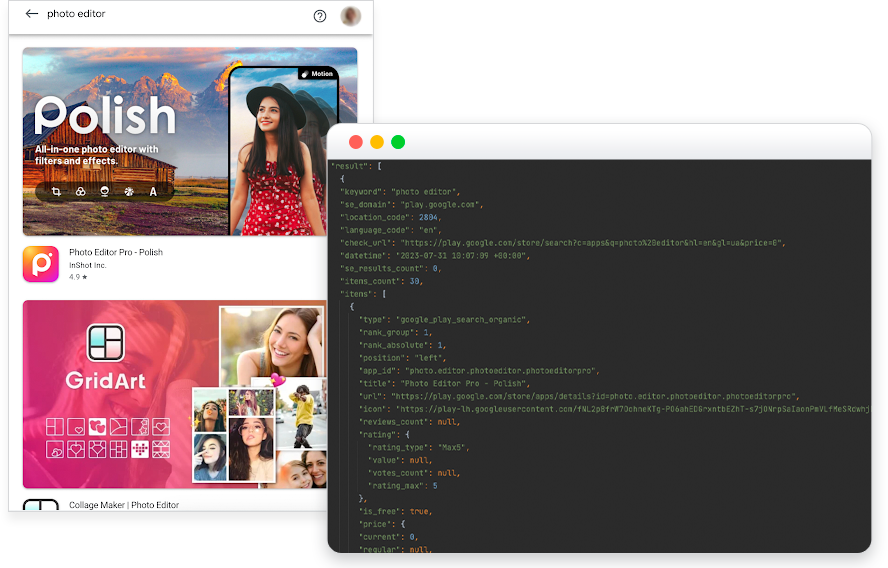Collect real-time app data at scale with Google Play Store API
The Google App Data API provides all possible app-related information from Google Play. This includes retrieving a list of apps that rank for a specific keyword, collecting a complete list of apps for any category and detailed information about a particular app, as well as checking reviews for any app that you can find on Google Play.
Learn available data points
App Listings
With the help of the App Listings endpoint, you have the opportunity to explore diverse collections of apps and gather invaluable insights about applications that are specifically relevant to certain niches.
This endpoint will provide you with a list of applications accessible on Google Play within the designated categories, along with supplementary details such as their unique ID, title, description, categories, icon, review count, rating, and pricing information.
App Info
To achieve effective App Store Optimization, it is crucial to gather comprehensive data on a wide range of competitor apps. By utilizing the App Data API, you will have access to extensive information regarding millions of apps available on both Google Play and the App Store platforms.
Through this endpoint, you can obtain essential details about a specific mobile application by making a POST request. The response will include the app's ID, icon, description, reviews count, rating, number of installs, images, and other relevant data.
App Reviews
Utilize the Review endpoints of the App Data API to gather feedback data for any application available on Google Play.
This specific endpoint grants access to an array of feedback data about applications featured on the Google Play platform. It encompasses review ratings, review content, user profile information of each reviewer, publication dates of reviews, and other relevant details.
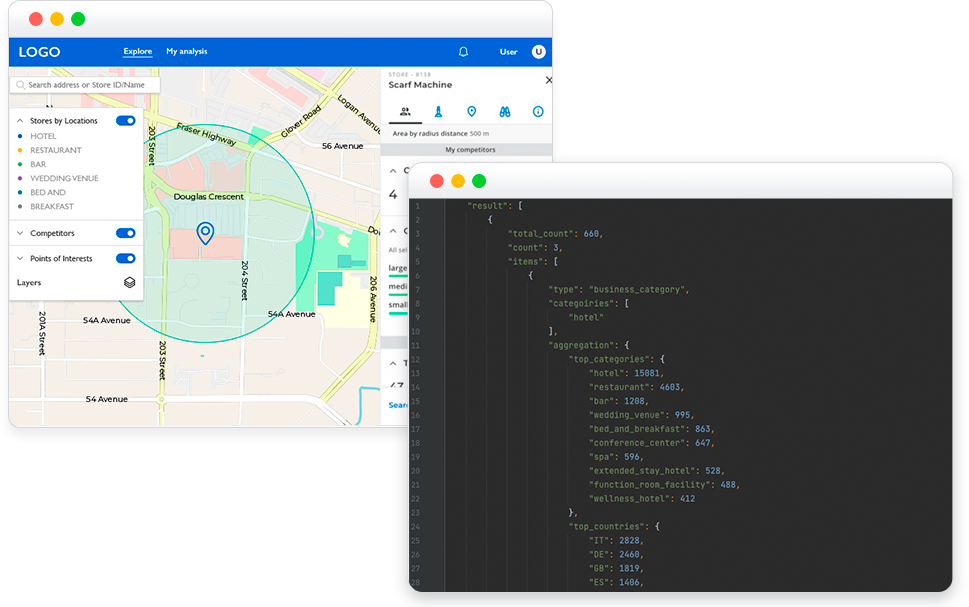
App Searches
The App Searches endpoints of the Apps Data API offer the capability to uncover applications that have achieved a certain ranking based on a specific keyword.
By making a POST request with the desired keyword, this endpoint provides an extensive list of apps that are currently ranked on Google Play. In addition to app names, it also furnishes valuable information about each application such as its unique identifier (ID), icon, number of reviews received, overall rating, price details, and other relevant data points.
App List
Through the App List endpoint, you can get Google Play app collections and access details about apps that pertain to a particular niche.
The results are tailored to the specified app collection, as well as the location and language parameters provided in the POST request and returns app list along with app IDs, ratings, prices, titles, and more for every app.
Cost-efficient solution
for budget-concious businesses



Need help with
a cost estimate?
Release in days, not weeks
Integrating a new data source can take a lot of time and money. We accelerate this process by providing a user-friendly interface for controlling your API usage and spending.
DataForApps offers detailed documentation for every parameter, field, and function you can come across while using our APIs and databases.
Every DataForApps user has access to a comprehensive graphic user interface (GUI) and can monitor and control every aspect of data usage.
Our support team is available 24/7 to ensure you get the required assistance and all your requests are addressed promptly and proficiently.
Find answers to your questions
Do I need to sign a contract?
Working with us, you don’t have to sign any contracts and be bound by any conditions. We provide services based on the pay-as-you-go pricing model, so you won’t even have to pay fees or subscribe to plans. Just add funds to your account and use them for obtaining the data. The balance has no expiry date.
Should something go wrong with a task?
We charge your balance only when you get a result. In case something goes wrong and you don’t receive the task result you won’t be charged for that.
Is data you provide real-time?
Yes, it is. What happens is you make an API call and our server checks and reports the result back. In other words, data is delivered in real-time for a specified search engine, language, and location.
How reliable and trustworthy are your APIs?
We have been using our scraping technologies for more than six years in our projects. As a separate service, we have been providing the APIs for over two years. You can check out our service’s performance and functionality using a free trial $1 credit and DataForApps Sandbox.
How long does it take to complete a task?
It depends on task priority and overall system load. You can find the average turnaround time of our APIs on the Pricing page.
Most of our APIs feature a system of queue priorities: tasks with higher priority have shorter turnaround times, while Live tasks are executed in real-time.






